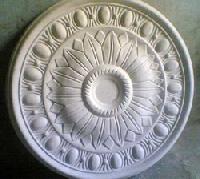
Gypsum Plaster
We are offering gypsum plaster, or plaster of paris, is produced by heating gypsum to about 300 °f (150 °c):[2] caso4·2h2o + heat → caso4·0.5h2o + 1.5h2o (released as steam). When the dry plaster powder is mixed with water, it re-forms into gypsum. The setting of unmodified plaster starts about 10 minutes after mixing and is complete in about 45 minutes; but not fully set for 72 hours.[3] if plaster or gypsum is heated above 392°f (200°c), anhydrite is formed, which will also re-form as gypsum if mixed with water.[4] a large gypsum deposit at montmartre in paris led "calcined gypsum" (roasted gypsum or gypsum plaster) to be commonly known as "plaster of paris". Plaster may also be used to create complex detailing for use in room interiors. These may be geometric (simulating wood or stone) or naturalistic (simulating leaves, vines, and flowers) these are also often used to simulate wood or stone detailing found in more substantial buildings. In modern days this material is also used for false ceiling. In this the powder form is converted in a sheet form and the sheet is then attached to the basic ceiling with the help of fasteners. It is done in various designs containing various combinations of lights and colors.
...more
Commercial Gypsum Powder
Commercial powder is use in industry plasters have been in use in passive fire protection, as fireproofing products, for many decades. The finished plaster releases water vapor when exposed to flame, acting to slow the spread of the fire, for as much as an hour or two depending on thickness. It also provides some insulation to retard heat flow into structural steel elements, that would otherwise lose their strength and collapse in a fire. Early versions of these plasters have used asbestos fibres, which have by now been outlawed in industrialized nations and have caused significant removal and re-coating work. More modern plasters fall into the following categories: fibrous (including mineral wool and glass fiber) cement mixtures either with mineral wool or with vermiculite gypsum plasters, leavened with polystyrene beads, as well as chemical expansion agents to decrease the density of the finished product one differentiates between interior and exterior fireproofing. Interior products are typically less substantial, with lower densities and lower cost. Exterior products have to withstand more extreme fire and other environmental conditions. Exterior products are also more likely to be attractively tooled, whereas their interior cousins are usually merely sprayed in place. A rough surface is typically forgiven inside of buildings as dropped ceilings often hide them. Exterior fireproofing plasters are losing ground to more costly intumescent and endothermic products, simply on technical merit. Trade jurisdiction on unionized construction sites in north america remains with the plasterers, regardless of whether the plaster is decorative in nature or is used in passive fire protection. Cementitious and gypsum based plasters tend to be endothermic. Fireproofing plasters are closely related to firestop mortars.
...more
Gypsum Powder

Plaster Of Paris
Be first to Rate
Rate This